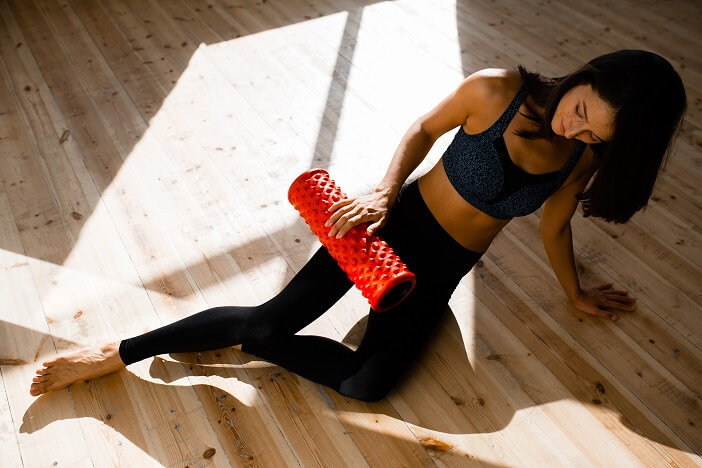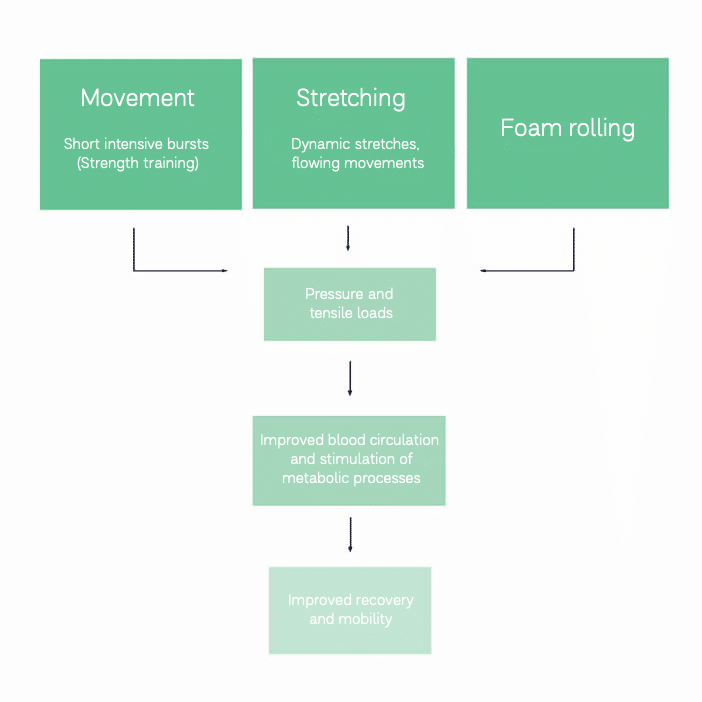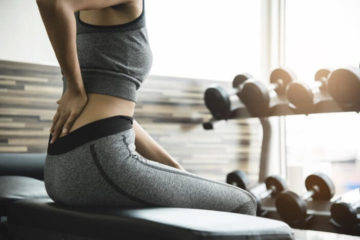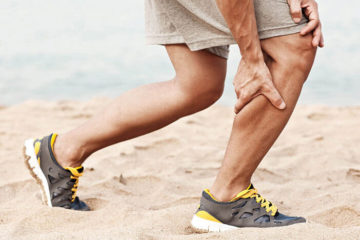Foam rollers - Effects, Exercises, Advantages and Disadvantages

Whether for competitive athletes, recreational athletes or physiotherapists – foam rollers have become an indispensable part of many people’s fitness routines. They are intended to relieve tension, prevent muscle ache, tackle cellulite and much more. But do they live up to their countless promises? We will explain what benefits they really offer, what mistakes you should avoid making and how you can integrate a foam roller into your training.
More than just a casing: Fasciae

You will be familiar with the connective tissues made of fascia if you have ever prepared a piece of meat: these tissues are the thin white threads that are usually cut away. In the body, however, they are far from disposable!
Fasciae perform numerous vital functions.
Here are 10 facts about fasciae to give you a little insight into what this long-underestimated tissue is capable of:
- The fascial tissue is a network of connective tissue fibers with different proportions of collagen and elastin.
- Fasciae envelop the entire body (Muscles, joints, organs, nerve tracts, etc.), giving it stability and holding it together.
- Fasciae renew themselves approximately every two years through the connective tissue cells contained in it.
- Fasciae transport important nutrients to the cells and organs.
- Fasciae transport lymphatic fluid and therefore contribute significantly to keeping tissue supple.
- As it forms a complete network, the fascial tissue is an important means of communication between cells and organs.
- The enormous elasticity of the superficial fascia allows for changes to the body’s condition (e.g. pregnancy).
- The relative low elasticity of deep and visceral fascia ensures stability and tensile strength.
- Fasciae contain numerous nerve pathways and receptors for different stimuli, which is why they are also considered sensory organs.
- Fasciae have a massive impact on our flexibility and muscle strength. On the other hand, these abilities can also be affected by stress and exercise.
Types of fascial tissue
Fasciae can have both elastic and stabilizing properties – depending on their primary intended function. At a glance, there are three types of fascial tissue: superficial fascia, deep fascia and visceral fascia.
| Facial tissue | Properties |
|---|---|
| Superficial fascia |
|
| Deep fascia |
|
| Visceral fascia |
|
Pain caused by tight fascia

What can cause the fascia to become painful? The answer here is quite simple. If we move too little, put strain on one side, or are stressed, our fasciae remodel themselves. The proportion of tensile material (collagen) gets higher and the elastic material (elastin) is reduced. This results in tense fasciae. The high tension hinders the flow of lymphatic fluid. Lymphatic fluid normally ensures the flow of nutrients and waste materials. The reduced flow of lymphatic fluid leads to an increased release of fibrin, a protein that’s made in the body and primarily involved in coagulation. Fibrin ultimately causes the various layers of a fascia to stick together.
Note: you won’t necessarily feel pain where the origin of the problem is, as it can “migrate” to other places due to the cross-linking of the fascia.
The result is that we develop tension, pain and feel stiff. Once this process has been set in motion, it often leads to a vicious cycle. Due to the tense fascia, we feel stiff and do not want to move because of this, which in turn just causes the fascia to get stiffer. This imbalance leads to inflammatory processes and is therefore considered a significant risk factor for chronic diseases.
What is a foam roller?

A foam roller is a piece of training equipment made of rigid foam. According to its inventor, it can be used for both the activation of muscles before sports, and for their regeneration after sports. Foam rollers are available in different sizes, shapes, colours and degrees of firmness.
Foam rollers work by exerting pressure on the muscle.
This pressure helps the lymphatic fluid to move, which sets metabolic processes in motion. Thus, waste material can be removed more effectively and the tissue can be supplied with new fluid. Think of the muscle as a sponge. You squeeze out the old liquid, so that the sponge can soak up clean water again. This helps the fasciae become more supple and can reduce pain.
What does science say about the trend?
The advertised capabilities of foam rollers look very promising: They supposedly reduce muscle pain, prevent muscle soreness, improve mobility and fight cellulite. Sounds like a real miracle workers, right?
From a scientific point of view, these statements are only partially true. There are certainly studies that support the promise of increased regeneration and joint mobility from regular foam rolling. However, some results highlight that the positive effects from foam rolling cannot be properly measured and are only subjectively perceived. Of course, don’t underestimate the effect that feeling good has on your mood and motivation to exercise. However, to assume that the foam roller has an active effect on the tissue seems to be more of a fallacy. Other claims such as reducing cellulite have also not been proven so far.

The fact is that pressure and tensile loads improve blood circulation and stimulate metabolic processes. This helps to smooth fasciae. This can generally be achieved from most movement and stretching. However, connective tissue is particularly well stimulated by dynamic stretching exercises, short intense stimulation (e.g. strength training) and fluid movements (e.g. yoga or QiGong).
Foam rolling is suitable to complement training. However, rolling alone won’t do wonders.
It’s also important to remember that factors such as genetics, hormones, diet and stress can have a huge impact on the amount of tension in the fascia and muscles. So it makes sense to always consider the body as a whole, especially when there is a problem.
Correct use

If you take a few things into account, the correct use of a foam roller is neither dangerous nor difficult to implement. Here you will find an overview of the most important measures to take for effective training with a foam roller:
| DO | DON’T |
|---|---|
| Roll over the entire length of the respective muscle | Roll only a small part of a muscle (e.g. the thickest part of the calf instead of the Achilles tendon) |
| Only roll in one direction (towards the heart) – (just a suggestion, opinions differ greatly here) | Roll back and forth quickly |
| Make 5-10 rolling movements per muscle | Roll over the same spot for several minutes |
| Roll from the beginning of the muscle to the end | Roll over joints |
If you want to activate the muscle before training, the speed of rolling should also be a little faster. For regenerative purposes, however, this should be carried out very slowly and evenly.
The way to get the most out of foam rolling is to apply it in a 2-day routine. This means foam-rolling one day and taking a break the next day, and so-on. Beginners should gradually build up to this optimal frequency. The more you get used to it, the more you can use it. In any case, 3-4 times a week is quite enough.
Exercises with a foam roller
Keep reading to discover a few basic exercises for the main muscle groups. Each of these exercises can be modified to suit both beginners and advanced fitness routines!
Foot sole

- Stand shoulder-width apart, push your pelvis forward, put your foot on a mini foam roller (or alternatively a tennis ball) and roll over the entire plantar fascia with light pressure.
- Variant: Raising or pointing your toes.
Calf

- Sit on the floor, lean back, and support yourself with your hands, bend one leg and place the calf of the other on the foam roller, lift your bum and roll from your Achilles tendon to the back of the knee.
- Variant: Extend your bent leg and place it on the other; point or flex the foot.
Thighs and hip flexors

- For the back of the thigh: Remain in the same position as for the calf, place the roller under your thigh, roll from the back of your knee to just before your bum.
- For the outside: Support yourself with your hands, roll over and put your upper leg forward, roll from knee to hip.
- For the front: Support yourself on your forearms, place one or both thighs on the roller, raise your knees, roll from knee to hip. Important: Keep your abdominal muscles flexed.
- For the inner side: Support yourself with your forearms, bend one thigh and place the inner side on the roller, stretch out the other leg, and roll from knee to hip. Important: Keep your abdominal muscles flexed.
Buttocks

- For both sides: Put on the roller in the middle, lean back on your hands, roll over the entire bum muscles.
- One-sided: Place one foot on the other thigh, tilt to the side of the raised leg and support yourself with your hands, roll over the bum muscles.
- Important: Do not roll into the lumbar spine.
Back

- Place the roller under your lumbar spine, bend your legs, put your hands on the back of your neck or cross your arms in front of your chest and keep your stomach tensed to stabilise the spine. Roll from your lumbar spine to your shoulder blades.
- Important: Do not roll over your neck, tilt your chin towards the chest.
Contraindications

Foam rolling is not suitable for everyone. There are certain criteria that you need to consider before you start including it in your training.
In principle, if you are taking strong painkillers do not use foam rollers, because your natural perception of pain may be masked. The same applies after an operation with acute tissue inflammation or extreme muscle soreness. In these cases, further microdamages may be caused by foam rolling, which can impair the healing process of the already existing injuries.
If any of the following conditions apply to you, you should also not use foam rollers.
- Taking anticoagulants
- Diabetes
- Rheumatism (joint diseases)
- Osteoporosis (weakening of bones)
- Severe damage to the intervertebral discs
- Brittle bone disease
- Fibromyalgia
- Pregnancy
Some of these conditions make foam rolling unfavourable for certain parts of the body, others however make foam rolling unsuitable in general. If in any doubt, always consult a specialist.
Advantages and disadvantages of foam rolling
| Advantages | Disadvantages |
|---|---|
| A simple and quick method of self-massage | Not all muscles can be targeted with the roller |
| Can increase or decrease the pressure as required | Eventually, the pressure will no longer be sufficient |
| Improves regeneration and mobility | Incorrect use, or disregard of contraindications can cause damage |
| Usually perceived as pleasant with regular use | Can be very tiring due to the many different positions |
Which foam roller is the best?

With the wide range of foam rollers available, it can be overwhelming to choose the right one. Is a small, medium or large roller better? Is a textured surface better? Should it have a dip in the middle? Do I also need a foam roller ball? Let us help clear all these questions up, so you can make the right decision.
Size
When choosing the size, the main consideration is what you want the roller for. The mini-versions are particularly suitable for feet and arms. They are convenient for travel or at work, but not absolutely essential. The standard version (about 30 cm long) is very versatile and therefore also suitable for many people. The extra-long version may be a good idea for stronger people, but otherwise has no significant advantage over the standard length. There are also narrower rollers which are only suitable for those with experience as they provide a more intense rolling.
Degree of firmness
A medium degree of firmness is suitable for both beginners and advanced users with a normal pain perception. Very sensitive people should go for a soft roller. Hard foam rollers are only suitable for advanced users. If you are new to foam rolling and don’t have any extreme pre-existing pain, you usually can’t go wrong with a medium firmness.
Texture
Whether you choose a smooth or textured foam roller depends on, how intense of an effect you’re after. Smooth surfaces have a very gentle effect. On the other hand, textured surfaces offer an additional massage effect. Therefore, for a beginner, a smooth foam roller is better suited at first.
Shape
Most foam rollers have a continuous cylindrical surface. However, rollers also exist with a dip in the middle. These are especially suited to the back, as they protect the spine, and so they work very well in addition to a normal foam roller. The same effect can be achieved with a so-called duo-ball massagers which provide a more intense effect.
With massage balls, it is also possible to target areas that can’t be reached with a roller. In addition, they provide a more intense treatment, since they target very specific areas. Their biggest strength is that they can help release trigger points – these are isolated areas which can cause a lot of pain.
Conclusion: How useful are foam rollers?
If you expect a fascia roller to do everything it says on the tin, you will be disappointed. They aren’t miracle workers that will cause your back pain or cellulite to suddenly disappear. However, they can help you recover more quickly and improve your mobility. If you follow the simple rules of use, nothing can go wrong. In any case, exercise is still the best way to feel fit and agile.
The scientific opinion is not yet uniform in some cases. However, certain results do prove the effects described. Overall, the hype surrounding foam rollers is quite justified – still, you shouldn’t believe all promises. It’s well worth giving this inconspicuous piece of equipment a try and seeing the effect it has on your own body!
Frequently Asked Questions:
What are foam rollers?
A foam roller is a training device made of rigid foam. It can be used to activate and regenerate the muscles both before and after sports.
How do you use foam rollers?
Always roll over the entire length of the respective muscle, i.e. from the beginning of the muscle to the end of the muscle. In addition, only roll in one direction – and in the direction of the heart. 5-10 Rolling movements per muscle is enough.
Do foam rollers really work?
Yes, with a foam roller you can improve your recovery and mobility. It is a simple, quick way to relieve tension at home. However, you should not expect a miracle – you will get the most out of foam rolling in combination with regular exercise.
Sources
- Fleckenstein et al. (2017). Preventive and Regenerative Foam Rolling are Equally Effective in Reducing Fatigue-Related Impairments of Muscle Function following Exercise. In: Journal of Sports Science and Medicine. 16: 474-479.
- Beardsley, Skarabot (2015). Effects of self-myofascial release: A systematic review. In: International Journal of Sports and Physio Therapy. 10(2): 203–212.
- MacDonald et al. (2014). Foam rolling as a recovery tool after an intense bout of physical activity. In: Medical Science Sports Exercises. 46: 131–142.



